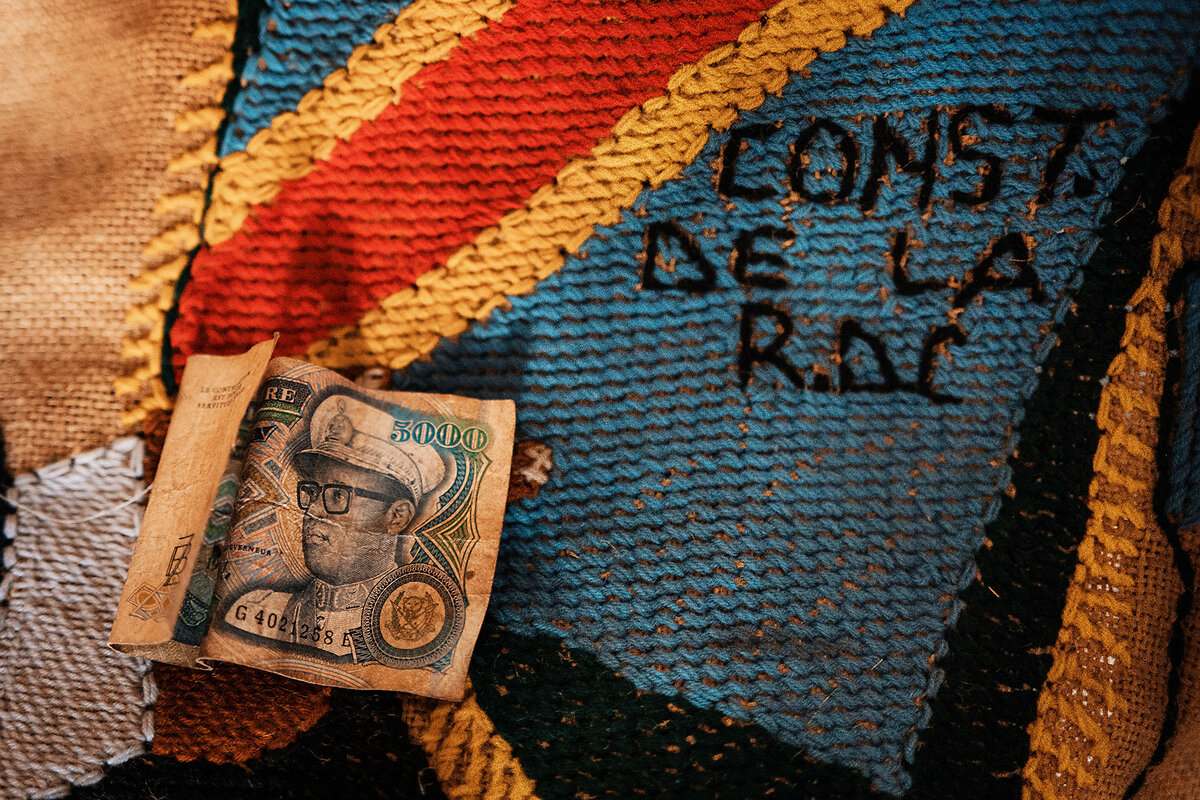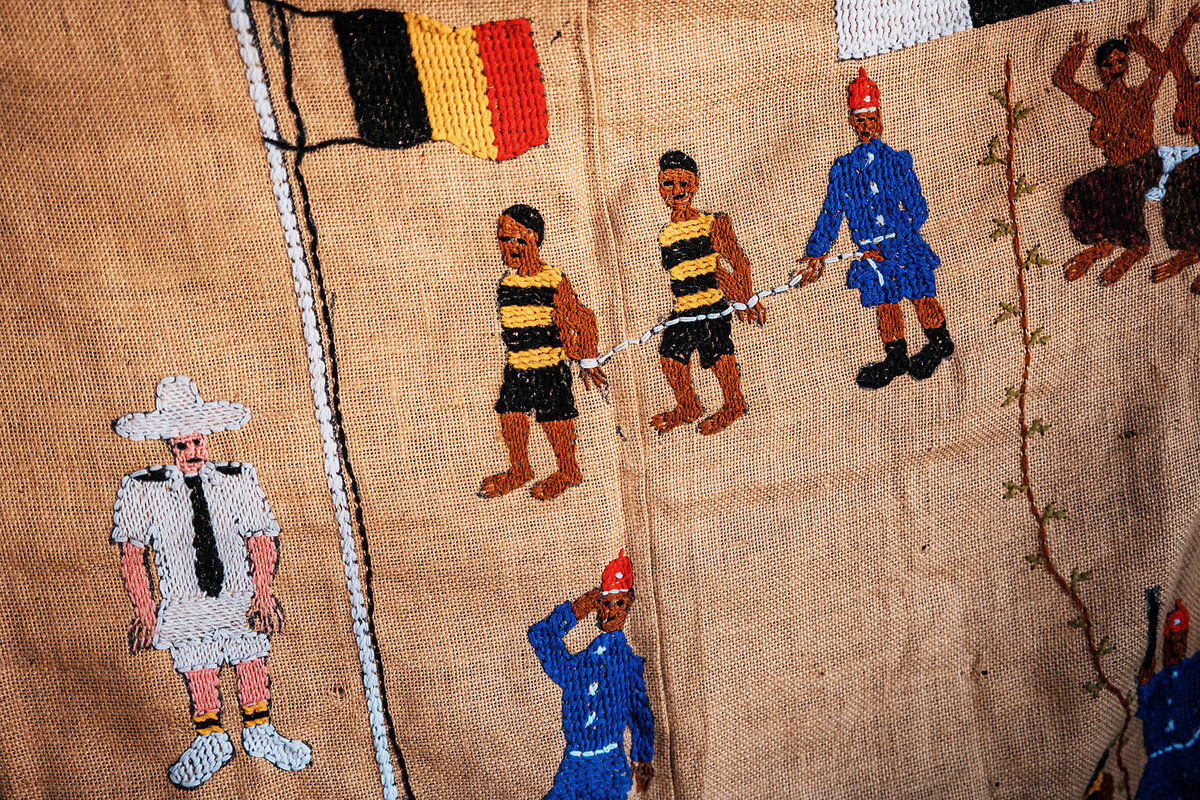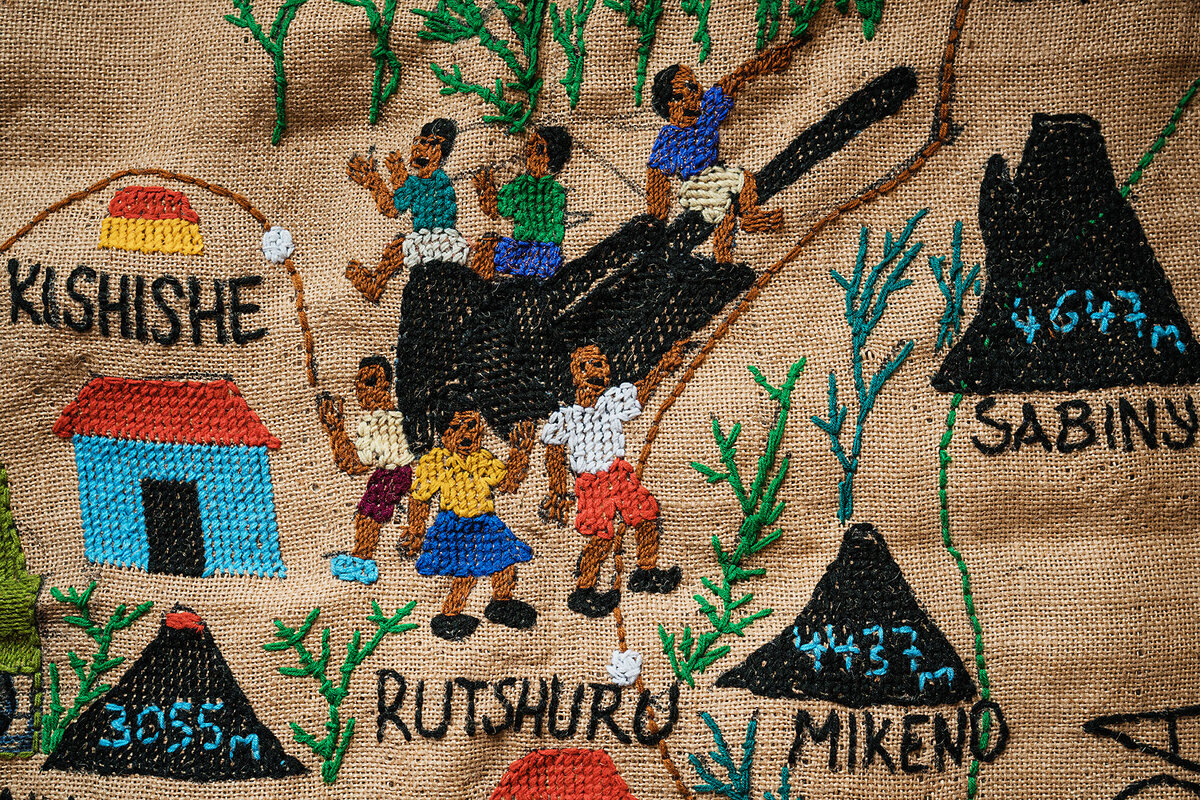In Congo, embroidery artist stitches an archive of war
Loading...
| Goma, Congo
Needle grasped in her wrinkled fingers and tongue between her lips, Lucie Kamuswekera pulls a length of green string in and out of a piece of burlap, stitching a soldier’s uniform the color of pine needles.
She is working on a tapestry depicting a clash between Congolese soldiers and rebel fighters. In the background, civilians flee beneath the spray of gunfire.
For 30 years, the artist has documented war in the eastern Democratic Republic of Congo this way, with her needle and thread. Her works, which have been exhibited in museums and galleries around the world, depict the staggering human toll of a generation of unbroken conflict.
Why We Wrote This
A story focused onEmbroidery artist Lucie Kamuswekera stitches vast tapestries depicting the human toll of Congo’s wars. She says she wants this history to be remembered so that it will not be repeated.
From colonial rule to attacks by armed groups, Ms. Kamuswekera stitches images of events that many around her long to forget. She does so, she says, because she believes ignoring the past will allow it to repeat itself.
“I wanted to preserve [these moments] for the future,” she says. “People will come after many years, and they will see. They will learn the history of our country.”
A vibrant archive
Ms. Kamuswekera, who is 80 years old, learned embroidery as a young girl in missionary school, when Congo was still a Belgian colony.
The nuns taught her to stitch delicate flowers and birds, and for decades, as she built her career as a nurse, that was all she thought to make.
Then, in the mid-1990s, violent conflict broke out in eastern Congo as rebel groups, supported by neighboring governments, fought to overthrow Congo’s longtime dictator, Mobutu Sese Seko. The war’s battlefields bled into the countryside, making the conflict extraordinarily dangerous for civilians. In 1997, Ms. Kamuswekera’s husband was killed while walking to their farm.
After that, she says, she didn’t want to sew flowers anymore.
“Today I am making pictures of war, because we are in a war,” she says simply. “When the war ends, I will make pictures of peace.”
Ms. Kamuswekera works from a small studio made of clapboard and cinder block, which juts out from the front of her home on the outskirts of the city of Goma. Dusty sunlight filters through holes in the corrugated metal roof, and the walls are covered floor to ceiling with her art. Brightly colored plastic sacks stuffed with more works clutter the floor, serving as both informal storage and additional seating in the cramped space.
The small room is a vibrant archive of recent Congolese history.
One of the largest works shows Congolese men with their hands bound and backs lashed, in punishment for upsetting the Belgian colonial authorities. Four others carry an official in a white hat atop a palanquin. It is a scene Ms. Kamuswekera says she witnessed herself.
On the opposite wall is a rendering of Laurent-Désiré Kabila, the former Congolese president, who took power in the war that killed her husband.
After that conflict, the First Congo War, ended in 1997, another began almost immediately. Since then, eastern Congo has endured repeated waves of violence, which have killed more than 6 million people.
Ms. Kamuswekera’s tapestries document these wars in detail.
Most recently, she has created artwork about the rebels from the March 23 Movement, or M23. Originally founded by disgruntled Congolese soldiers in 2012, the rebel group has grown more active over the last two years, allegedly backed by the governments of neighboring Rwanda and Uganda.
The latest of these tapestries were rendered as the rebels encircled Goma in recent months.
Some of Ms. Kamuswekera’s hangings have political messages. One, depicting women cowering behind bushes and trees, demands an end to sexual violence. In another, a man weeps below a banner decrying the sale of Congo’s mineral wealth, the text of which asks how the country can be so rich and so poor at once.
Ms. Kamuswekera embroiders from memory when she can. When she cannot, she questions other observers, fastidiously ensuring that each detail she stitches is accurate.
The artist also uses a stack of images given to her by a photojournalist, which provide a portal to places she has not seen.
Her work is painstaking. Stitching a human face takes five days’ careful embroidery, but selling the tapestries is hard.
“People don’t buy,” Ms. Kamuswekera says glumly, clasping her hands together. Even when she makes a sale, she anxiously wonders when the next customer will arrive.
Meanwhile, the conflicts she documents affect her daily life, too. The latest surge in violence has made roads in and out of Goma unsafe, driving up the price of food and other necessities.
Sometimes, she thinks about quitting embroidery altogether.
“The history will not disappear”
Constantly reliving Congo’s conflicts has also taken its toll on the artist. One day, she hopes to make art celebrating peace instead.
At the bottom of a wall, in the far back corner of her studio, is a tapestry showing people happily drinking and playing drums beside their thatched huts. Ms. Kamuswekera describes it as a celebration of Pan-Africanism. She wants to make more like it.
But at the age of 80, her concentration is beginning to ebb. Her eyesight is fading and her knees pain her. She finds it difficult to sit for long hours pulling her needle repetitively in and out of burlap.
Determined to ensure her craft lives on, the artist is now passing her skills on to her children, grandchildren, and great-grandchildren.
“Everybody in the family knows this art,” her grandson Jojo Lukongya says proudly.
These pupils sit watching as she works, their concentration as taut as the threads in Ms. Kamuswekera’s hands. Mostly, though, they learn by doing, quickly taking up tapestries of their own.
Because Ms. Kamuswekera cannot speak French, her family members sketch French titles atop each tapestry, which the artist carefully traces in yarn. “Non à la Corruption,” reads one. “La mort de Lumumba,” reads another that depicts the life and death of Congo’s first postindependence leader.
“We shall take it up and continue her work,” says her great-granddaughter Phenic Kahindo Musyanilya, while weaving images of different villages caught in battles between rebel factions in the M23 conflict. “The history will not disappear nor be forgotten.”
Reporting for this story was supported by the Pulitzer Center.










